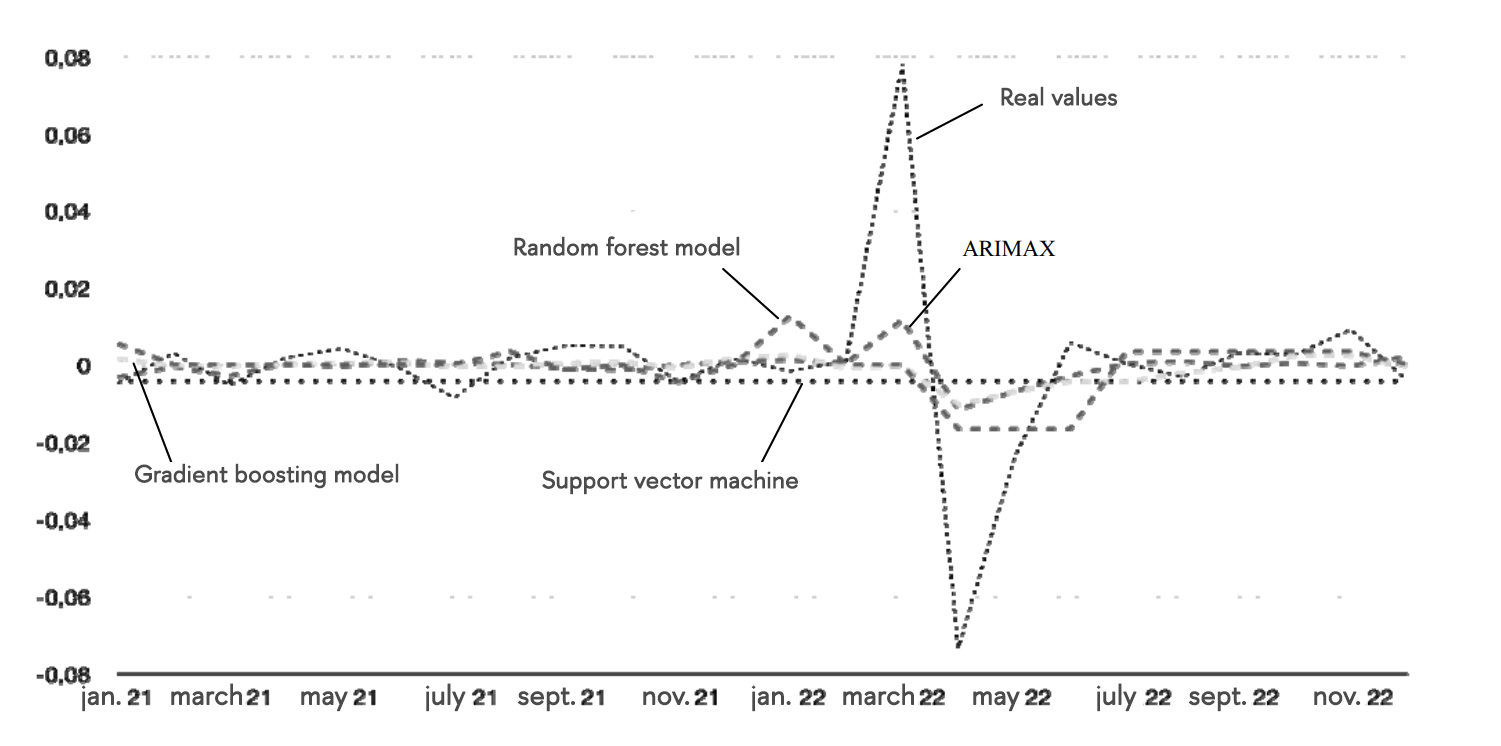HSE Researchers Demonstrate Effectiveness of Machine Learning in Forecasting Inflation

Inflation is a key indicator of economic stability, and being able to accurately forecast its levels across regions is crucial for governments, businesses, and households. Tatiana Bukina and Dmitry Kashin at HSE Campus in Perm have found that machine learning techniques outperform traditional econometric models in long-term inflation forecasting. The results of the study focused on several regions in the Privolzhskiy Federal District have been published in HSE Economic Journal.
Inflation forecasting is crucial for the economy, particularly since Russia's transition to an inflation targeting regime in 2014. This means that the Bank of Russia sets specific inflation targets and employs a range of tools to meet them.
Various data is used to predict inflation, including the consumer price index, the unemployment rate, exchange rates, and the Central Bank rate. To systematise this information for forecasting, economists at the HSE Campus in Perm used data from the Unified Interdepartmental Statistical Information System.
The researchers' main objective was to determine which model predicts regional inflation more accurately: traditional econometric time series models or more recent machine learning methods. The study analysed data from 14 regions in the Privolzhskiy Federal District from January 2010 to December 2022. R Studio and Python were used for the analysis: time series forecasting was performed in R Studio, while machine learning models, including support vector machines, gradient boosting, and random forests, were implemented in Python. The forecasts were conducted on test samples, which helped prevent model overfitting and provided more accurate estimates.
The authors employed a cross-validation method using test samples of equal size. This approach allows models to be trained on data from one period and tested on data from another, ensuring stability and accuracy of the forecasts.
'To ensure accurate performance of machine learning methods, it is essential to select the optimal hyperparameters for the models. Hyperparameters differ from other model parameters in that they are set before training begins and define the model's specifications. Cross-validation is employed to select the optimal hyperparameters. When cross-validating time series, the training data precedes the test data without overlap, unlike in standard data validation,' according to Tatiana Bukina, Associate Professor, Faculty of Computer Science, Economics, and Social Sciences, HSE Campus in Perm.
The study found the gradient boosting model to be the most accurate of all machine learning models considered for predicting regional inflation. It delivers more accurate forecasts than autoregressive models over more time horizons. Thus, at forecasting horizons of 3, 6, 21, and 24 months, the gradient boosting model outperforms the basic AR(1) model by 20.3%, 16.2%, 72.5%, and 77.7%, respectively. The AR(1) model, a statistical tool for analysing and predicting time series, assumes that the current value of a series depends on its previous value plus a random error.
The random forest model and the support vector machine also demonstrated accurate forecasts over the long horizons of 21 and 24 months, outperforming the AR(1) model by 72.5% and 77.7%, respectively. A random forest combines multiple decision trees to enhance the accuracy and stability of forecasts, and then uses regression to average the predictions or select the most frequent value. The support vector machine identifies the optimal line that separates the data while minimising classification errors.

According to the authors, their results confirm that machine learning methods can be effective for forecasting inflation across various time horizons.
Tatiana Bukina notes, 'Our research has demonstrated that machine learning provides more reliable tools for long-term forecasts. However, traditional econometric models continue to play a crucial role in short-term forecasts and should not be entirely excluded from analysts' toolkits. Combining econometric modelling with machine learning methods can significantly improve the accuracy of regional inflation forecasts. This is particularly important in an environment characterised by high uncertainty and rapid changes in economic conditions.'
The study also highlighted the specific characteristics of inflation forecasting for different regions. For example, in machine learning models, inflation seasonality was observed only in the Perm, Nizhny Novgorod, Penza, and Saratov regions. In the Republic of Tatarstan, the specific month for which the forecast was calculated proved to be a significant factor.
In the random forest model, the average inflation value for the previous three months emerged as a significant factor for the Republic of Mordovia, Nizhny Novgorod and Ulyanovsk regions, and the Chuvash Republic.
Each region has unique characteristics related to its economic structure, natural resources, and geographical location. These factors account for the variations in inflation dynamics and key macroeconomic indicators.
See also:
HSE Scientists Reveal How Staying at Alma Mater Can Affect Early-Career Researchers
Many early-career scientists continue their academic careers at the same university where they studied, a practice known as academic inbreeding. A researcher at the HSE Institute of Education analysed the impact of academic inbreeding on publication activity in the natural sciences and mathematics. The study found that the impact is ambiguous and depends on various factors, including the university's geographical location, its financial resources, and the state of the regional academic employment market. A paper with the study findings has been published in Research Policy.
Group and Shuffle: Researchers at HSE University and AIRI Accelerate Neural Network Fine-Tuning
Researchers at HSE University and the AIRI Institute have proposed a method for quickly fine-tuning neural networks. Their approach involves processing data in groups and then optimally shuffling these groups to improve their interactions. The method outperforms alternatives in image generation and analysis, as well as in fine-tuning text models, all while requiring less memory and training time. The results have been presented at the NeurIPS 2024 Conference.
When Thoughts Become Movement: How Brain–Computer Interfaces Are Transforming Medicine and Daily Life
At the dawn of the 21st century, humans are increasingly becoming not just observers, but active participants in the technological revolution. Among the breakthroughs with the potential to change the lives of millions, brain–computer interfaces (BCIs)—systems that connect the brain to external devices—hold a special place. These technologies were the focal point of the spring International School ‘A New Generation of Neurointerfaces,’ which took place at HSE University.
New Clustering Method Simplifies Analysis of Large Data Sets
Researchers from HSE University and the Institute of Control Sciences of the Russian Academy of Sciences have proposed a new method of data analysis: tunnel clustering. It allows for the rapid identification of groups of similar objects and requires fewer computational resources than traditional methods. Depending on the data configuration, the algorithm can operate dozens of times faster than its counterparts. Thestudy was published in the journal Doklady Rossijskoj Akademii Nauk. Mathematika, Informatika, Processy Upravlenia.
Researchers from HSE University in Perm Teach AI to Analyse Figure Skating
Researchers from HSE University in Perm have developed NeuroSkate, a neural network that identifies the movements of skaters on video and determines the correctness of the elements performed. The algorithm has already demonstrated success with the basic elements, and further development of the model will improve its accuracy in identifying complex jumps.
Script Differences Hinder Language Switching in Bilinguals
Researchers at the HSE Centre for Language and Brain used eye-tracking to examine how bilinguals switch between languages in response to context shifts. Script differences were found to slow down this process. When letters appear unfamiliar—such as the Latin alphabet in a Russian-language text—the brain does not immediately switch to the other language, even when the person is aware they are in a bilingual setting. The article has been published in Bilingualism: Language and Cognition.
HSE Experts Highlight Factors Influencing EV Market Growth
According to estimates from HSE University, Moscow leads in the number of charging stations for electric vehicles in Russia, while Nizhny Novgorod ranks first in terms of charging station coverage, with 11.23 electric vehicles per charging station, compared to 14.41 in Moscow. The lack of charging infrastructure is one of the key factors limiting the growth of the electric vehicle market. This is stated in the study titled ‘Socio-Economic Aspects of Introducing Electric Vehicles in Commercial Transportation’ conducted by experts from the Institute of Transport Economics and Transport Policy Studies at HSE University.
Machine Learning Links Two New Genes to Ischemic Stroke
A team of scientists from HSE University and the Kurchatov Institute used machine learning methods to investigate genetic predisposition to stroke. Their analysis of the genomes of over 5,000 people identified 131 genes linked to the risk of ischemic stroke. For two of these genes, the association was found for the first time. The paper has been published in PeerJ Computer Science.
First Digital Adult Reading Test Available on RuStore
HSE University's Centre for Language and Brain has developed the first standardised tool for assessing Russian reading skills in adults—the LexiMetr-A test. The test is now available digitally on the RuStore platform. This application allows for a quick and effective diagnosis of reading disorders, including dyslexia, in people aged 18 and older.
Low-Carbon Exports Reduce CO2 Emissions
Researchers at the HSE Faculty of Economic Sciences and the Federal Research Centre of Coal and Coal Chemistry have found that exporting low-carbon goods contributes to a better environment in Russian regions and helps them reduce greenhouse gas emissions. The study results have been published in R-Economy.



